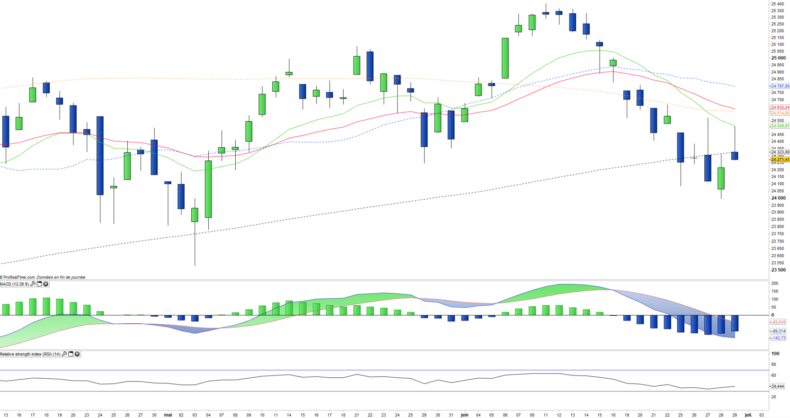SPDR Dow Jones ETF - DIA - 02/07/2018
Short Term strategy: Negative (30%) / Trend -
Long Term strategy: Positive (90%) / Trend -
pour accéder à nos achats / ventes sur les indices
Characteristics of the ETF
The DIA ETF (SPDR) replicates the Dow Jones Industrial Average index, which is composed of the 30 main US stocks, the "blue chips", selected according to the size of their market capitalization. The DIA ETF is currently the benchmark tracker to replicate the most prestigious and old US index with fees limited to 0.17% and AUM of $ 20897M. Replication is direct (physical) and there is a policy of distributing dividends on a monthly basis.
Alternative ETFS: IYY (iShares in USD)
Latest developments
The DJIA grew by 25.1% in 2017, and decreased by 1.8% since the beginning of 2018.
The US index remains quite resilient, despite the serious threats posed by the rise in long-term rates and the trade war initiated by D.Trump towards its main partners, China, Europe, Canada or Mexico.
This resilience is linked to several factors, which are primarily the tax reform initiated by D.Trump which triggers a return of capital to the US and which will have a significantly favorable impact on the corporate results, secondly the rebound of the oil prices that will impact favorably the results of the sector which remains key in the United States and which represents 5.8% of the index. Then the third factor is the Fed, which for the moment remains accommodative and sticks to a gradual rise in interest rates to preserve growth.
However, D. Trump's trade actions are beginning to worry the markets, and have tangible consequences on both the dollar's level, inflation expectations and, in turn, emerging market countries that often carry debt in USD and which see their currency drop sharply. The resilience of the Dow Jones could end up finding its limit.
Index & components
For a US company, integrating the Dow Jones is considered a consecration, so much must be established to achieve it, so sit there as America's iconic companies like IBM, Coca Colas, Boeing or Goldman Sachs.
The value of this index is primarily the quality and robustness of its components, while the average market capitalization is $ 233 bn, with a balanced sector weighting of which the 3 main sectors are industrial stocks (22.2%) including big names such as 3M, Dupont de Nemours or Boeing, financial stocks (15.3%) with the big American banks, the technological sector (18.2%) including the most established names like IBM, Apple and Microsoft.
The DJIA is a much narrower index than the S & P500 and may be more volatile, for example when financial stocks are under pressure. The Dow Jones multiples are currently around 18x 2018 results, which is clearly in the high average (historically between 15 and 20x) but must be compared to a growth of the economy of over 2% in a context of still low interest rates and an industry sensitive to oil prices that has begun to rise.
The index has been posting record highs for the last few months, and climbed the 26,000 pts threshold at the beginning of the year. The index benefited from the election of D.Trump and his promises of a massive infrastructure program (pending), tax cuts (done) and the announced deregulation of banks that also benefits these sectors.
The new round of rate hikes should remain gradual unless the signs of inflation intensify, while the US dollar is now rather strong against the Euro and other currencies which should be a drag for US companies if the trend continues. The upward trend of the index, which has lasted for 8 years, seems to suggest that the longevity of the cycle is linked to the low rate / moderate growth pair that may still last for some time.
Weekly data
On the weekly chart, we can see that the last three weeks have been corrective, which leads to the downgrade of the EMA26 and a false crossover of the MACD, two rather negative factors. However the candlesticks are limited in size, unlike what happened in the correction of the beginning of the year, and there is no panic. Moving averages are flattening and a crossover in the coming weeks is not to be ruled out.
Daily data
The daily chart shows a new bearish attack that was once again halted by the EMA200. This support is very worked - it's the fourth attack since the beginning of the year - and could eventually give way, especially since the rebound last Friday has aborted and made a pull-back on the EMA100 which is not reassuring.
ETF Objective
DIA is an ETF listed in USD, which seeks to replicate the DJIA index (30 US companies)
Characteristics
| Inception date | 14/01/1998 |
| Expense ratio | 0,17% |
| Issuer | SPDR |
| Benchmark | Dow Jones Industrial Average |
| Code/Ticker | DIA |
| ISIN | US78467X1090 |
| UCITS | No |
| Currency | $ |
| Exchange | NYSE Arca |
| Assets Under Management | 20 932 M$ |
| Dividend | distribution |
| Currency Risk | No |
| Number of Holdings | 30 |
| Risk | 3/5 |
Country Breakdown
| USA | 100% |
Sector Breakdown
| Industrials | 22% |
| Information Technology | 18% |
| Financials | 15% |
| Consumer Discretionary | 15% |
| Health Care | 13% |
| Consumer Staples | 7% |
| Energy | 6% |
| Materials | 2% |
| Telecommunication Services | 1% |
Top Ten Holdings
| Boeing | 9% |
| Goldman Sachs | 7% |
| UnitedHealth Group | 7% |
| 3M Company | 5% |
| Apple | 5% |
| Home Depot | 5% |
| McDonald's Corp | 4% |
| Caterpillar | 4% |
| IBM | 4% |
| Visa Inc | 4% |


